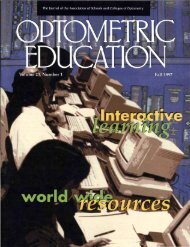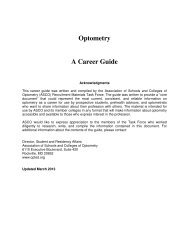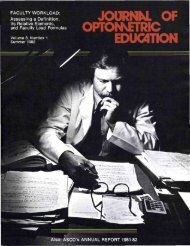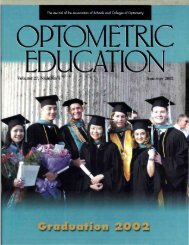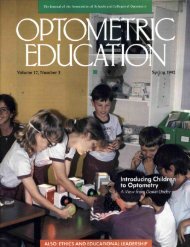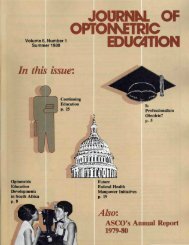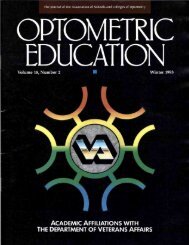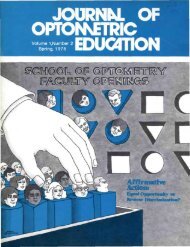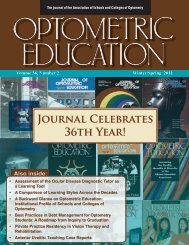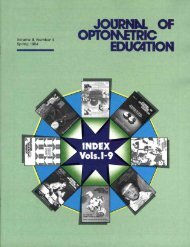Winter 1992, Volume 17, Number 2 - Association of Schools and ...
Winter 1992, Volume 17, Number 2 - Association of Schools and ...
Winter 1992, Volume 17, Number 2 - Association of Schools and ...
Create successful ePaper yourself
Turn your PDF publications into a flip-book with our unique Google optimized e-Paper software.
RESOURCES<br />
IN REVIEW<br />
The Vision Care Assistant —<br />
An Introductory H<strong>and</strong>book,<br />
Pamela Miller, Vision Extension,<br />
Santa Ana, CA, 1990,112 pp., s<strong>of</strong>t<br />
cover, $15.00.<br />
The Vision Care Assistant — An<br />
Introductory H<strong>and</strong>book serves as a<br />
guide to the new paraoptometric<br />
working in an optometric practice.<br />
The book is divided into short<br />
chapters which briefly cover front<br />
<strong>of</strong>fice procedures, terminology,<br />
ocular anatomy, ocular emergencies,<br />
ocular pharmacology <strong>and</strong><br />
pathology, the vision examination,<br />
dispensing, lenses, tints <strong>and</strong> coatings,<br />
contact lenses, vision therapy,<br />
low vision, <strong>and</strong> occupational<br />
vision. Several examples <strong>of</strong> forms,<br />
checklists, <strong>and</strong> telephone scripts<br />
which can be modified for each<br />
individual practice are included<br />
<strong>and</strong> provide an organized<br />
approach to scheduling <strong>and</strong><br />
patient instruction.<br />
The Vision Care Assistant is easy<br />
to read <strong>and</strong> underst<strong>and</strong> <strong>and</strong> gives<br />
a general overview <strong>of</strong> optometric<br />
assisting for someone new in the<br />
field. It provides an entry point for<br />
those paraoptometrics interested<br />
in learning more <strong>of</strong> the theory<br />
behind the skills that they perform,<br />
<strong>and</strong> can serve as a guide on<br />
many topics associated with optometric<br />
assisting.<br />
I liked the book for its basic<br />
approach to the different topic<br />
areas. It provides a starting point<br />
for the education <strong>of</strong> on-the-job<br />
trained assistants <strong>and</strong> can be used<br />
to introduce them to the many<br />
areas <strong>of</strong> optometry. The reference<br />
list is good because it encourages<br />
advanced learning; however, the<br />
dates on some <strong>of</strong> the texts should<br />
be updated to reflect current editions.<br />
This book appears to be too<br />
basic for use in formal education<br />
programs, as it does not go into<br />
enough depth on the various topic<br />
areas.<br />
The Vision Care Assistant would<br />
be a nice addition to the optometric<br />
practice that trains its own staff<br />
<strong>and</strong> could be used by the new<br />
assistant to obtain a basic underst<strong>and</strong>ing<br />
<strong>of</strong> optometric practice. It<br />
could also be used by the paraoptometric<br />
who has been in the field<br />
for awhile <strong>and</strong> wants a quick overview<br />
<strong>of</strong> some <strong>of</strong> the topic areas.<br />
Guest Reviewer:<br />
Ms. Barbara Hetrick<br />
Program Director<br />
Owens Technical College<br />
Toledo, Ohio<br />
Vascular Disorders <strong>of</strong> the<br />
Ocular Fundus, A Colour<br />
Manual <strong>of</strong> Diagnosis, Rodney<br />
Grey, Butterworths, London, 1st<br />
edition, 1991,118 pp., including<br />
index, hardbound, $85.00.<br />
According to the author, this<br />
book "is intended to bridge the<br />
gap between the basic general<br />
textbooks <strong>and</strong> the comprehensive,<br />
multiple volume works." The text<br />
is written in an easy-to-read style<br />
<strong>and</strong> is organized in a logical manner<br />
with sub-groupings <strong>of</strong> retinal<br />
vascular diseases. Included is a<br />
discussion <strong>of</strong> normal vasculature,<br />
fluorescein angiography, photocoagulation,<br />
as well as the varieties<br />
<strong>of</strong> retinal <strong>and</strong> choroidal vascular<br />
disease. It is a text that has<br />
been written for the clinician<br />
rather than the academic. There is<br />
a reference list at the end <strong>of</strong> each<br />
section.<br />
The recommended management<br />
<strong>and</strong> treatment techniques are well<br />
written but fall short in the area <strong>of</strong><br />
diabetic retinopathy. Several <strong>of</strong><br />
the most recent studies regarding<br />
diabetic retinopathy management<br />
are not cited. The text does not<br />
adequately address the most<br />
important topic <strong>of</strong> diabetic retinopathy.<br />
There is no mention <strong>of</strong> the<br />
importance <strong>of</strong> glycosylated hemoglobin<br />
levels <strong>and</strong> the relationship<br />
to the predictability <strong>of</strong> proliferative<br />
diabetic retinopathy.<br />
Color photographs <strong>and</strong> accompanying<br />
fluorescein angiographies<br />
are adequate but would be more<br />
useful if printed in a larger format.<br />
The text is well indexed.<br />
I suppose one could say that<br />
the text bridges the gap between<br />
the general <strong>and</strong> the specific, but it<br />
could be a better bridge. Unfortunately,<br />
the author's intentions<br />
regarding atlases are <strong>of</strong>ten not<br />
realized because <strong>of</strong> the publisher's<br />
reluctance to give ground regarding<br />
color photos. There are several<br />
color photos in this text but their<br />
size detracts from their effectiveness.<br />
I would recommend this text<br />
only after the individual doctor<br />
has personally taken the time to<br />
review it to see if it fits his/her<br />
needs.<br />
Guest Reviewer:<br />
Dr. Larry J. Alex<strong>and</strong>er<br />
University <strong>of</strong> Alabama at<br />
Birmingham<br />
School <strong>of</strong> Optometry<br />
Immediate Eye Care — An<br />
Illustrated Manual, Nicola K.<br />
Ragge <strong>and</strong> David L. Easty, Mosby<br />
Year Book, St. Louis, 1991, 288 pp.,<br />
illustrated with many color photos<br />
<strong>and</strong> color drawings, hardbound,<br />
$89.00.<br />
Immediate Eye Care is a nice<br />
h<strong>and</strong>book for clinicians <strong>and</strong> trainees.<br />
Part I covers common eye diseases<br />
from the front to the back <strong>of</strong><br />
the eye in separate chapters while<br />
Part II addresses more specialized<br />
areas <strong>of</strong> interest including: neuroeye,<br />
trauma, pediatrics, occupational<br />
eye diseases, tropical eye<br />
diseases, drug induced problems,<br />
post-operative conditions, contact<br />
lenses <strong>and</strong> corneal donation.<br />
The book is written in a short<br />
synopsis style, with brief paragraph<br />
descriptions that are illus-<br />
62 Optometric Education



